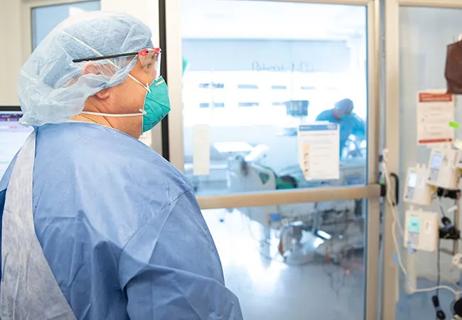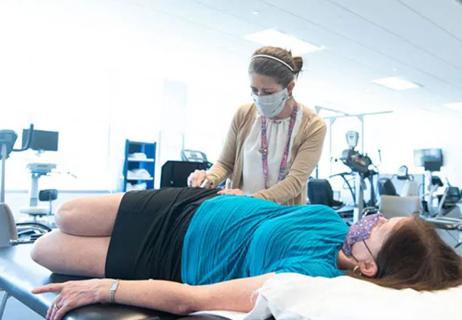Dr. Joel Press draws on the past to outline a dynamic future

For clues to the future of musculoskeletal care in the U.S., look to its past. That’s a key takeaway of comments by renowned physiatrist Joel M. Press, MD (above), when he addressed an audience of PM&R professionals at the 2016 Daurine and Sanford Noll Lecture hosted by Cleveland Clinic’s Department of Physical Medicine and Rehabilitation.
Cleveland Clinic is a non-profit academic medical center. Advertising on our site helps support our mission. We do not endorse non-Cleveland Clinic products or services. Policy
Dr. Press should know. When he was one of the founding members of PASSOR — the American Academy of Physical Medicine and Rehabilitation’s (AAPMR) musculoskeletal council — in the late 1980s, medicine was changing, needs for effective nonsurgical musculoskeletal care were great and there was a clear opportunity to integrate PM&R strategies into mainstream musculoskeletal care. All three of those factors are still at play today, said Dr. Press, and physiatrists can learn much from the specialty’s successes and shortcomings over the intervening three decades — a period during which he served as president of the AAPMR, PASSOR, the North American Spine Society and other major bodies in the discipline.
“We’ve come a long way, but we still have far to go,” said Dr. Press, who recently moved from the Rehabilitation Institute of Chicago to become Chairman of the Department of Physiatry and Physiatrist-in-Chief at the Hospital for Special Surgery in New York. “And we have to get there quickly because of the pace of change in healthcare.”
Dr. Press outlined what he and his colleagues got right and wrong when they formed PASSOR 30 years ago to advance the musculoskeletal component of PM&R.
He said their chief successes included improving awareness of physiatrists as musculoskeletal specialists and boosting interest in musculoskeletal care among physiatrists themselves — as evidenced by the fact that nearly half of AAPMR’s membership now belongs to its musculoskeletal council.
At the same time, Dr. Press identified three areas he wishes PASSOR had addressed more effectively:
Among his various learnings throughout his years of leadership, Dr. Press devoted particular focus to what lies behind his sense that the entire medical profession has done a poor job documenting what works and what doesn’t. “We all have too many personal interests in the treatments we use and in maintaining our own status quo,” he said. “Interpretations of outcomes data too often depend on which side of the tracks you’re on.”
He cited the example of how two sets of guidelines issued in 2009 for managing chronic low back pain came to vastly differing conclusions about the efficacy of epidural steroid injections. Guidelines from the American Pain Society, whose members generally do not perform high volumes of such injections, stated that there was “sparse evidence” supportive of such injections for spinal stenosis, axial pain and failed back surgery syndrome, concluding that they offer “no clear benefit.” In contrast, guidelines from the American Society of Interventional Pain Physicians, whose members generally perform many such injections, came out with strong Level I endorsements of caudal epidural steroid injections for managing disc herniation or radiculitis and for discogenic pain without disc herniation or radiculitis.
“These groups looked at the same set of studies!” Dr. Press observed. “Too often conclusions depend on one’s perspective.”
But the rise of value-based care demands that this change, he argued. “We cannot continue doing certain interventions simply because we can,” he said. “Increasingly we will be paid for keeping people healthy and not increasing healthcare utilization. The value is in knowing what to do, when to do it and in whom to do it.”
This is where Dr. Press sees a golden opportunity for PM&R to display its value. He cited a growing body of evidence demonstrating the success of multidisciplinary nonsurgical low back pain clinics in reducing treatment costs with equivalent or better patient outcomes relative to the standard of care for low back pain — which invariably leads to more surgeries. While many examples are contemporary —such as studies by Fox, Rasmussen and Sarro — one well-designed prospective study dates back to 1975. “Again, there are lessons to heed from the past,” noted Dr. Press.
He said a common thread among the initiatives in these and other studies is — in the words of the Institute of Medicine report, Crossing the Quality Chasm — an emphasis on “optimizing systems of care and care processes within organizational structures to build interprofessional teams and establish cultures of collaboration.”
“That sure sounds like PM&R to me,” said Dr. Press, noting that physiatry is ahead of other specialties in organizing into “integrated practice units” around patient needs. That care model, increasingly advocated by health economists and other thought leaders, calls for multidisciplinary, co-located teams to take responsibility for the full cycle of a patient’s care — outpatient, inpatient and supporting services.
“It’s a validation and an inspiration that Dr. Press’ vision for the future of PM&R aligns so well with Cleveland Clinic’s new population health program for patients with chronic low back pain,” said Frederick Frost, MD, Chair of Cleveland Clinic’s Department of Physical Medicine and Rehabilitation. “Our multidisciplinary program [detailed in this post] prioritizes functional outcomes over pills and procedure-based care to take on both the opioid epidemic and the proliferation of inappropriate, sometimes mutilating spine surgeries.”
PM&R figures prominently in that new Cleveland Clinic program for low back pain, which doesn’t surprise Dr. Press. “Physiatry is well placed in the hierarchy of need for value-based musculoskeletal care, especially low back care,” he said. “We can see clearly where the future is going. Let’s make sure we’re part of the solution.”

Joel Press, MD, speaks after the lecture with Cleveland Clinic PM&R staff.

Q&A with Brain Trauma Foundation guideline architect Gregory Hawryluk, MD, PhD

Q&A with newly arrived autoimmune neurology specialist Amy Kunchok, MD

A neurocritical care specialist shares what’s spurring growth of this new evaluation approach

Focused ultrasound offers a newer alternative to deep brain stimulation

Prehabilitation can help improve outcomes after spine surgery

Get ready for central vein sign and optical coherence tomography

How these new drugs fit into practice two years out from their first approvals

A conversation on the state of physiatry with the AAPM&R’s Vice President